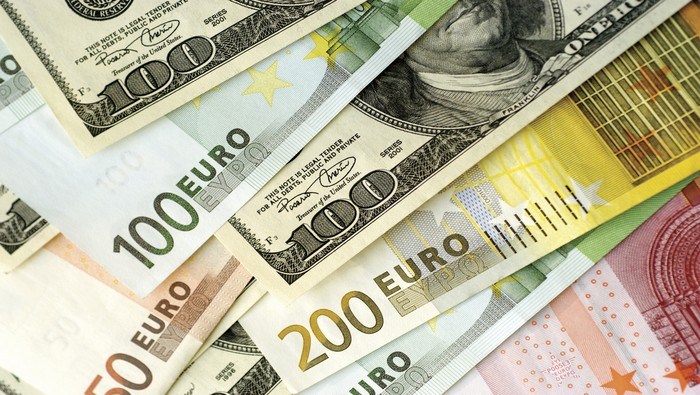Main financial assets discussed: Euro (EUR), U.S. dollar (USD), Invesco CurrencyShares Euro Trust (FXE) ETF
Top 3 key points:
1. The relative interest rate differential between the European Central Bank (ECB) and the U.S. Federal Reserve (Fed) has been a key driver of the Euro's strength against the U.S. dollar in the past.
2. The changing tone of the ECB, with President Christine Lagarde being more dovish, and the diverging economic performance between the U.S. and Europe suggest that the Euro may weaken against the U.S. dollar.
3. Speculative positioning in the Euro is at its longest in years, and technical indicators suggest a potential breakdown in the Euro's value.
Recommended actions: **Sell** the Euro or the FXE ETF. Short the Euro directly via FX markets or buy a put spread on the FXE ETF.
The euro fell to a two-month low against the dollar and a 12-month low against the pound after German and eurozone business activity slumped more than expected in August, leading to concerns about the state of the European economy and potential pauses in tightening measures by the European Central Bank, while the dollar rose to a two-month peak amid positive U.S. economic data.
The euro reached a 15-year high against the yen due to signs of inflation in Europe, while the dollar weakened ahead of economic data that could indicate a softening economy.
The US dollar experienced weakness due to disappointing economic data, leading to speculation that the Federal Reserve may not need to be as aggressive in its monetary policy settings, while equities showed modest gains; Chinese PMI numbers beat estimates but concerns about the property sector lingered; USD/JPY dipped before recovering; and the DXY index stabilized after recent losses, with potential support levels identified.
The outlook for the euro area remains uncertain as economic activity has slowed and indicators suggest weakness ahead, but the labor market remains resilient; a restrictive monetary policy is critical for bringing inflation back to the 2% target in a timely manner, and a data-dependent and robust approach to monetary policy is warranted due to the high level of uncertainty.
The euro weakened following comments from ECB rate-setter Isabel Schnabel, raising uncertainty about whether interest rates will be raised in September.
The dollar's strength is expected to be difficult to overcome for most major currencies by year-end, according to a Reuters poll of forex strategists, with risks to the greenback outlook skewed to the upside.
The value of the U.S. dollar has been strengthening against the Euro and the British Pound due to the continuing strength of the U.S. economy and the weakness of the European economies.
The US Dollar performed strongly against major currencies, with the Euro experiencing its 8th consecutive weekly loss and the Chinese Yuan performing poorly, while global market sentiment was negative and stock markets weakened. In the coming week, market focus will be on the US inflation report, UK employment and GDP data, Australian employment data, and the ECB rate decision.
The euro has been continuously decreasing in value against the dollar for the eighth consecutive week, reflecting the economic challenges faced by Europe, including high inflation and the specter of recession, while the United States has better control over inflation and a stronger labor market, leading to a widening gap between the euro and the dollar.
The European Central Bank's decision to signal its last rate hike has further weakened the euro, causing hedge funds and speculators to anticipate potential parity with the dollar.
European markets are pessimistic ahead of central bank meetings, energy prices raise the risk of secondary inflation, and the US dollar is gaining strength, which may negatively impact precious metals and cryptocurrencies.
The US dollar strengthened on positive US economic news, higher bond yields, and hawkish comments from Federal Reserve officials, while the euro weakened due to dollar strength and hawkish comments from the European Central Bank.
The euro's outlook is worsening due to high oil prices and concerns about Italy's fiscal position, raising the risk of a return to the $1 mark.
The euro area is experiencing stagnated economic activity and weakening growth, leading the European Central Bank (ECB) to adjust its monetary policy by raising interest rates to combat inflation; however, uncertainties remain regarding the transmission of monetary policy and potential risks to economic growth.
The euro's value may fall to parity with the dollar again as US yields rise and concerns about euro-area growth and inflation persist.
USD/JPY is hovering around the psychological level of 150 with no sign of a reversal, while EUR/JPY struggles to extend gains and AUD/JPY remains range-bound, indicating a sideways bias for JPY crosses.
EUR/USD rebounds after recent weakness, but geopolitical tensions in the Middle East continue to pose a risk for riskier currencies.
